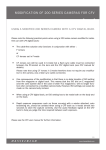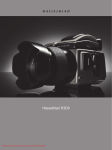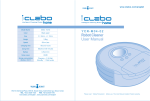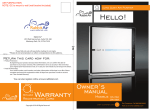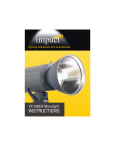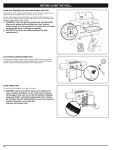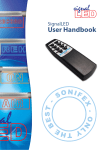Download User Manual - Amazon Web Services
Transcript
H4D User Manual H4D-200MS H4D-60 H4D-50MS H4D-50 H4D-40 H4D-31 H4D 1 $BSSZJOHTUSBQ 2 The carrying strap is attached by firstly withdrawing the safety collar. The hook is then freed and attached to the strap lug (fig. 1). Slide back the safety collar (fig. 2) to ensure the hook remains in the locked position between the small protruding lugs. The collar is purposely a tight fit and might need some effort to slide. Rechargeable battery grip 3 The Battery grip rechargeable 7.2V (3043348) is the standard power source for the H4D camera and is an environmentally approved Li-ion type. The H4D requires a power supply for all actions as there is no mechanical reserve facility. When working untethered, it is therefore advisable to keep a reserve rechargeable battery grip at hand. As is the case with most batteries, problems might be encountered when used in very low temperatures. In this situation it is advisable to keep the reserve battery in an inside pocket, for example, to maintain it near body temperature (both sorts of battery grips are referred to as the ‘battery’ in this manual). 4 C 1 A B Fitting and removing a battery 5 3, 4, 5 The fitting and removing procedure is the same for both types of battery grip. Remove the battery from the camera by depressing the battery holder button (A) and simultaneously swinging the battery holder retaining lever (B) down until it stops. Pull the battery downwards (C). If you intend to store the battery separately from the camera you should ensure that the safety cover is in place (to prevent shortcircuiting). It snaps into place and is removed by pulling outwards and upwards on the locking clip (fig. 4). 6 To fit, hold the battery flat against the camera body and aligning the two upper lugs with the slot, slide it back into position as far as it will go. Swing back the battery holder retaining lever until it clicks back into place. The battery charger 6, 7 The battery charger unit is supplied with five plug attachments to suit various types of domestic electrical sockets available worldwide. Other types of socket will require a domestic socket converter. Attach the chosen plug (fig 7) by sliding it into position, ensuring that the two electrical contact prongs on the charger correctly enter the two contact sockets on the plug attachment. Removal is by the reverse procedure. 7 Please note the Battery charger BC-H Li-ion 7.2 VDC (3053568) is designed for use with Battery grip rechargeable 7.2V units only. 25 H4D Parts and components – HVD 90x & HV 90x-II A B C D A. Rubber eye cup B. Hot shoe C. Eyesight adjustment wheel E F G D. Exposure compensation button E. Exposure method / mode button F. Integral flash unit H G. Flash unit release button H. Viewfinder release button "UUBDIJOHBOESFNPWJOHUIFWJFXöOEFS 1 1 2 While holding the viewfinder at a slight angle and resting it on the top of the camera, slide the viewfinder forward until the front locating pin is in position in the recess in the front edge of the viewfinder screen aperture on camera body. Press the rear part of the viewfinder firmly downwards until it clicks into place. Ensure that both sides of the viewfinder are seated correctly and that it has been firmly attached and locked into position. Failure to do so could cause an intermittent malfunction if the databus interface connections between the viewfinder and camera body are not positively secured. To remove, grasp the viewfinder in the right hand and while depressing the viewfinder release button, lift the rear of the viewfinder up and away from the camera body. &ZFQJFDFBEKVTUNFOU 2 No corrective lenses are needed to adjust the eyepiece to suit most requirements. The diopter range is from -5 to +3.5D. Eyeglass wearers can rapidly and accurately change the settings according to whether they wish to wear eyeglasses for viewing or not. Personal eyepiece adjustments can be carried out by pointing the camera at the sky or similar smoothly toned area. While holding the camera in your left hand, you can with your right thumb turn the adjustment wheel until the markings on the viewfinder screen reach the optimum sharpness for your eyesight. Note There are two different viewfinder models. The HVD 90x is for 36x48mm sensors (or smaller) cameras. The HV 90x-II is for the H4D-60. User functions are the same for both models. If you normally wear eyeglasses for distance viewing and intend to wear them for camera use then do not remove them for the above procedure. If, on the other hand, you prefer to remove your eyeglasses for camera work, then repeat the above procedure without wearing your eyeglasses. Rubber eye cup Two rubber eye cups are available for the H4D. The one supplied is suitable for users who do not intend to use eyeglasses when photographing. The second shorter eye cup is for those who either prefer to position their eye further from the viewfinder and those who wish to wear eyeglasses. The eye cups can be rapidly changed by a Hasselblad Authorized Service Center. Integral flash unit See under Flash for full details. 31 H4D Parts and components 1 A. B. C. D. E. A B C D Remove the front protective cover on the camera body by depressing the lens release button and keeping it depressed while turning the cover counter-clockwise. Remove the rear lens cap by unscrewing it in a counter-clockwise direction. Align the index on the lens with the index on the camera body and rotate the lens clockwise (bayonet fitting) until it clicks into place. 2 2 Removing a lens 1 3 Lens shade index Manual focus ring Focusing distance scales Depth-of-field scales Lens index "UUBDIJOHBMFOT E 1 Depress the lens release button and keep it depressed while rotating the lens counterclockwise until it stops and lift it out. Replace protective caps on the lens immediately and on the camera body if necessary. If you try to rotate the lens before you press the lens release button, it might lock. In this case, rotate the lens clockwise a little first and then re-attempt removal with the correct procedure: button first, then lens. Front lens cap 4 Front lens caps are released for removal and attachment by inserting a thumb and index finger into the recesses and pinching in the direction of the arrows. Filters 4 Filters have a screw thread fitting (67 / 77 / 95mm, according to lens) and are screwed clockwise into place. As there is no rotation of the front section of the lens when focus is changed, filters do not rotate either. This is particularly useful when using polarizing or graduated filters where the orientation is normally critical. Lens shades 5 5, 6 All lenses are supplied with lens shades that additionally provide extra protection for transport and storage when mounted in reverse. Lens shades have a bayonet fitting and are turned clockwise into place after ensuring the index on the lens shade aligns with the index on the front of the lens. When mounted in reverse, they are attached by matching the indexes and turning clockwise. Shutter and aperture control Both the shutter and aperture are electronically controlled and are adjusted by the control wheels on the grip. There are no separate manual setting rings on the lenses or camera body. The chosen settings are displayed both on the grip display and in the viewfinder display. See under Light Metering & Exposure Control / Exposure Method for a complete explanation. 6 %FQUIPGöFMEDBMDVMBUJPO There are two distance scales (in feet and metres) visible through the focus distance window on the upper part of the lens barrel. There is also a central lens index mark and a depth-of-field scale. The focusing distance is read off the chosen scale from the central lens index. 33 H4D Care and maintenance of sensor unit 1 Handling and storage t "MXBZTSFQMBDFUIFQSPUFDUJWF$$%öMUFSDPWFSXIFOUIFTFOTPSVOJUJTOPUNPVOUFE on the camera. t %POPUUPVDIUIFFYQPTFE$$%öMUFSXJUIZPVSöOHFST t ,FFQBMMGPSFJHOPCKFDUTPVUPGUIFDBNFSBPQFOJOH t 4UPSFUIFTFOTPSVOJUBXBZGSPNNPJTUVSFBOEFYDFTTJWFIFBU t 1SPUFDUUIFTFOTPSVOJUGSPNJNQBDUoEPOPUESPQJU 2 Cleaning the CCD Infrared Filter If you see dark or colored spots or lines in your images, then you may need to clean the outer surface of the sensor unit’s infrared (IR) filter. In most cases, the careful use of compressed air will be adequate though if you use canned compressed air, read the instructions very carefully before use to avoid spraying impurities or even ice on the filter! Sometimes, however, small particles will get stuck to the surface of the IR filter, requiring for a more thorough cleaning, involving either fluid or wipes. For a good safe cleaning, follow descriptions below. 3 Basic air-cleaning procedure / removing the sensor unit A B C 1. Remove a FireWire if connected. 2. Remove the viewfinder. 3. While pushing the safety catch backwards on the sensor unit (3 illus. A) push the lever of the sensor unit release button to the right (3 illus. B) and while maintaining that position press the centre of the button firmly inwards towards the camera body (3 illus. C) to finally release the magazine. 4. Clean the outside surface of IR filter by spraying it with clean compressed air (see warning above first). If this is not enough, then use one of the procedures outlined below. 5. Reattach the sensor unit to the camera immediately after cleaning to check results. 6. If you still see spots on your shots after you have cleaned the outside of the infrared filter, then you may have dust either on the inside of the IR filter or on the CCD itself. Note Never attempt to remove the glass filter from the front of the CCD – you will probably ruin the CCD if you do so. If dust manages to get between the IR filter and CCD, it can only be removed at the Hasselblad factory. Contact your Hasselblad dealer for assistance. 136 H4D Hasselblad A/S Hejrevej 30, DK - 2400 Copenhagen, Denmark Victor Hasselblad AB Box 220, SE - 401 23 Göteborg, Sweden 09.2011 - UK v15 141






